Israel

This country has never had the Constitution; it calls up women for military service and begins the workweek on Sunday. It venerates ancient traditions with heart and soul and constantly develops high technologies. Here, knowledge has always been highly appreciated: around 30% of the employed citizens have university degrees, and 12% have got Ph.D.
That is Israel — a tiny plot of poor land with an unfavourable climate. And despite the 50-year war with Arab countries, this region has turned into one of the world's most prosperous and influential states. Eretz, or land in Hebrew, is the name used by Israeli citizens to call their country; it is also called the land of milk and honey, according to the second Torah — The Book of Exodus.

General Information
For both Orthodox Christians and Catholics, Israel is the land where Christ was born. So a pilgrimage there at least once in our lives would be a good idea. Sunni Muslims aspire to visit this place to pay homage to their sacred sites, and Orthodox Jews consider it the world’s centre of spirituality restoration.
For those out of health, Israel frequently becomes the last hope for recovery. Israeli doctors have achieved impressive results in fighting cancer, female and male infertility, and other severe diseases.

A medical team performs surgery in a state-of-the-art operating room
The admirers of seaside resorts speak about the beaches of the Dead Sea, Tel Aviv, Eilat, and the Sea of Galilee with fascination.
Despite the complicated and turbulent domestic situation related to the long-lasting war, the influx of tourists to Israel has not decreased. Annually, around 4.5 million people arrive in the promised land to spend a vacation, study, undergo treatment, or work.
Historical Background
As a nation, Jews have existed for more than 3,500 years. However, the State of Israel (Medinat Yisrael) began its history on May 14, 1948. On that day, its first Prime Minister, David Ben-Gurion, declared the creation of the Jewish state within a narrow stripe of the Mediterranean coast in Southwest Asia. The decision was based on the UN Resolution, which was immediately rejected by the neighbours of a newly-formed country — the Arab League.

The Declaration of Independence of Israel on May 14, 1948
Not only did they turn down the fact that independent Israel emerged, but also declared war against it. Five enemies attacked the young republic — Egypt, Transjordan, Syria, Lebanon, and Iraq. The bloodshed lasted more than a year and ended with a cease-fire and recognition of Israel as a UN member state. However, the Arabs did not manage to create their own country within the disputed territory.

Volunteers evacuate a wounded man during the Egyptian bombing of Tel Aviv
Israeli authorities took drastic measures in relation to Arab refugees. The latter did not have access to the places where they had been living for centuries. And Arab countries introduced the same procedures towards the Jews and drove them into exile to the new state. As a result, the Jewish population in Israel accounted for more than two million, and 600,000 Arabs left.
The Arab-Israeli conflict is still active. But in 1978, the first landmark event took place: Egypt, as one of the Arab League members, gave formal recognition to the State of Israel. In 1994, Jordan joined. Nonetheless, there is still a volatile situation within the Gaza Strip and the West Bank — the Palestinian territories bordering Israel.

An Israeli army self-propelled howitzer fires shells near the Gaza border in southern Israel, October 11, 2023
Geography and Climate
The State of Israel does not have the Constitution and the officially recognised borders either. Factually, it borders Lebanon, Syria, and Egypt, and the fourth boundary was determined in 1949 when the Arab-Israeli War ended. It stretches across the River Jordan and is called Green Line.
This Middle East country has boundaries with the shores of the Mediterranean Sea on the west and the Red Sea on the south. There is also the landlocked waterbody — the Sea of Galilee. The Israeli climate is of the Mediterranean type, but the average season temperatures vary by region.
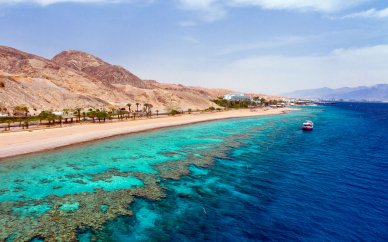
Coral beach, Red Sea, Israel
For example, winter is cold and snowy in the mountains and rainy within the coastal terrain. Summer in Israel is long and arid. It usually does not rain from May to September, but the heat is starching with the temperatures reaching +40°C. In the city of Beit Shean, there was a record temperature of +47°C.
Tourists usually are not in favour of hot weather, so summer and winter make a silent period. The high season starts when mild warmth comes — from September to November and from February to May. As a result, the prices for spending a vacation in Israel fluctuate. The cost for travel packages is the highest in summer and winter, and the lowest — in autumn and early spring.
Population, Language, and Currency
Israel is a small country where more than nine million people live; the majority of them are Jews (six million). Two million citizens are Arabs, and the rest belong to other ethnicities. Interestingly, the Land of Promise has gathered almost half of the Jews from across the globe: 44% of David’s descendants are Israeli passport holders.
The largest cities in Israel are Jerusalem (the capital, 950,000 residents), Tel Aviv (470,000), and Haifa (290,000).
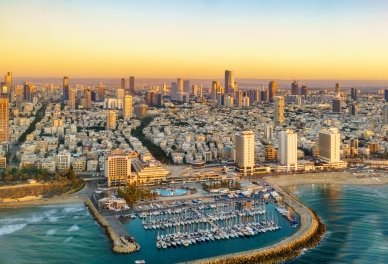
Tel Aviv, Israel
The official language is Hebrew, a unique discourse with its peculiar style of writing and history. For more than 1,800 years, it was used merely for conducting church services, writing religious and philosophical treatises, textbooks, and literary works. It was the beginning of the 20th century when Hebrew became conversational.
After the State of Israel was declared in 1948, the language was meant to obtain the status of the official. Though Arabic is widely spoken, it has a special status as the minority language.
The wave of repatriates in the 1990s amended the communication realities of the country. Almost every second citizen is fluent in Russian. The press and a big part of service sector employees and healthcare providers use Russian too. These are the reasons why the former USSR residents prefer spending vacations and undergoing medical treatment in Israel: they do not need the expensive services of an interpreter.
The Israeli new shekel, which emerged in September 1985, is one of the world’s youngest currencies. The exchange rate of USD - ILS is 1:0.32, and EUR - ILS is 1:0.28.
Directions
The best way of getting to Israel is to travel by plane. There are low-cost flights from many European cities that take three hours or longer. Travelling from the North American continent is a bit more complicated as such trips take a long time and fares are much higher. However, a great option is to get to any spot in Europe and then fly to Israel.
In Tel Aviv, Ben Gurion Airport services international flights. The visitors to Eilat arrive in Ramon, a new and only airport constructed after 1949 when Israel gained its independence. It is located a 15-minute drive from the resort. You may take bus #30 or #50 to get to the recreation area, and this will cost ₪4.20. A taxi is a time-saving option, but the fare is much higher (₪84 - ₪95 excluding the extra cost of luggage).
The State of Israel has visa exemption agreements with many countries, so it is recommended to check this list before starting your journey. However, the COVID-19 pandemic has amended the entry rules for tourists. The Israeli authorities require non-Israeli citizens to provide the certificate proving they have obtained the full course of WHO-approved vaccines or a certificate of Covid-19 recovery. Besides, every tourist arriving at the airport has to take a PCR test costing around ₪100. While waiting for the test result, they need to stay in isolation for 24 hours or longer, depending on the country of their arrival.

Accommodation
Planning a holiday in Israel, take into account that the standard of living here is very high, and thus the prices are the same. Besides, people from all over the world come here not only to spend their vacations. Undergoing treatment in Israeli hospitals is the other frequent reason for a big demand for rented accommodation and its high costs.
The minimum price of a hotel room is $50 per night; apartment rental may differ.
Below are several budget-friendly hotels in Israel:
- Tiberias Hostel is a low-cost hostel in Tiberias, Kinneret, not far from the Sea of Galilee. It offers free parking and Internet, breakfast for an extra charge. The rooms are equipped with air-conditioning, showers, and toilets. There are shops and a market nearby.
- Abraham Hostel Jerusalem is one of the best hostels in Jerusalem. The rooms are clean, with comfortable beds and fresh linen. There is free breakfast and beverages, Internet access, and a car park.
- Central Hotel in Tel Aviv offers rooms equipped with air-conditioning and central heating. There is also a fridge, ironing facilities, and a coffee machine in each room. The hotel also provides the guests with Wi-Fi and access to the beach.
- Haifa Nest Guesthouse in Haifa welcomes its guests with clean and cosy rooms and kitchenettes with necessary appliances. There is also free Wi-Fi and a car park.
- Clil Guest House is located amongst Galilee nature and offers its visitors to enjoy breathtaking views. The hotel is known for its relaxing atmosphere, friendly staff, clean and cosy rooms, and free Wi-Fi. Smoking is not allowed.
Renting accommodation in Israel is more cost-effective if you go as a group of people consisting of two or more families. The cost of large suites is divided proportionally, and thus it will be relatively inexpensive for each tourist. You may look for suitable rooms via international vacation rentals platforms like https://www.airbnb.co.uk/ or others.
Places to See
Israeli attractions reflect the episodes of the history of world religion. The majority of most visited places are in some way connected to the Biblical scenes.
Jerusalem
The place attracts people for whom Christianity is not merely one of the world’s major religions. Markedly religious Jerusalem is the home for a vast number of Orthodox Jews in comparison to secular Tel Aviv.
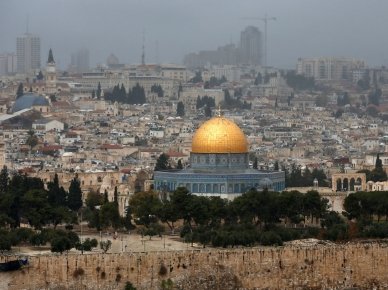
The Old City in Jerusalem
Church of the Holy Sepulchre and Via Dolorosa are the Christian holy sites of paramount importance, the must-see spots for everyone coming to Jerusalem. It does not matter to which faith people adhere. A Christian will arrive here to utter an ardent prayer, and a Muslim or a Buddhist will struggle to broaden their mind and show respect for one of the largest religions of the world.
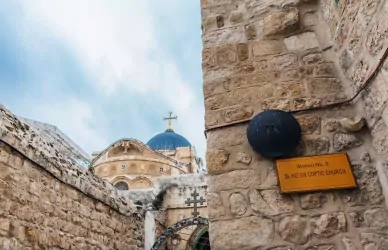
Via Dolorosa, Jerusalem
While there, visit the service conducted by clergymen of all Christian denominations, take a seat at the Altar of the Crucifixion to reflect upon the eternal things, and touch the rock of Calvary (Golgotha) where Jesus was crucified.
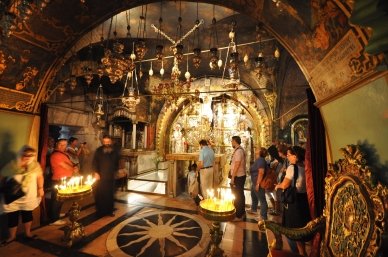
Traditional site of the Calvary or Golgotha where Jesus was crucified
Mount Zion is the Kingdom of God, as the Bible says. For every Jew, it is a symbol of the ancient homeland, the Jewish nation, and the wisdom of prophets. You may find it going to the south from Old Jerusalem to Zion Gate.
The path ahead is really difficult. The mountain rises to 765 m above sea level and opens breathtaking views of Jerusalem. The city, population of which is less than one million people, looks majestically.

Mount Zion in Jerusalem
Walk around the Abbey of the Dormition, which is, as the Bible says, the holy place of Assumption of Virgin Mary, the Mother of God. Right near the monastery, there is the monument to King David of Israel. There are usually so many tourists taking selfies and group photos at the two-metre statue of the ancient ruler.
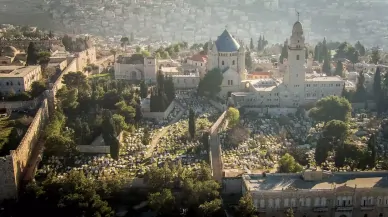
Abbey of the Dormition, Mount Zion
Not far from the Dormition, there is the Last Supper Room — the exact place where Jesus shared the last supper with his disciples. Now it is a small hall with pointed arches and windows, which has undergone construction several times.
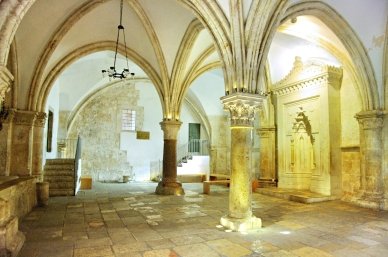
Last Supper Room, Jerusalem, Israel
The other sacred spot is King David’s tomb. However, nobody actually knows why it became considered a tomb as the exact burial site of the Biblical King is unidentified.
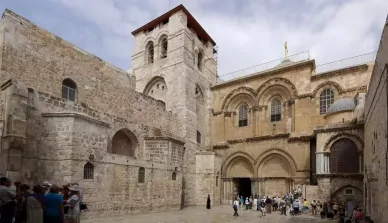
King David’s tomb
Mount Zion is also a site where a great German man Oskar Schindler, who saved 1,200 Jews during WWII, was buried. Even 50 years after his death, the number of rocks on his grave increases. They are brought here in his memory by the grateful ancestors of the saved people.
The Wailing Wall, also known as the Western Wall, means the same for every Jew as the Church of the Holy Sepulchre for Christians. This 485 metre-long segment of the Second Jewish Temple ruined by the Romans dates back to 70 AD. From every corner of the world, Jews come here to pray for the health and fulfillment of their fondest wishes. At the site, they also mourn over the barbaric destruction of the temple.

The Wailing Wall, Jerusalem
Bethlehem and the Dead Sea
A trip to this city, known to humanity since Biblical times, is a risky undertaking due to its location in Palestine, the party of the enduring conflict.
However, there are no problems getting here if to departure from Jerusalem. Bethlehem is the homeland of King David and Jesus Christ — two great sons of the Jewish people. The pilgrims visit this place to pray at the Church of the Nativity, the world’s oldest functioning temple, and go into the cave where Christ was born. The queue to the cave is so long that you will need much patience to anticipate. But you may also find an Arab man circling somewhere around and pay him money to get inside, bypassing the crowd of people.

Church of the Nativity
A tour of the Dead Sea is a must-see for everyone coming to Israel. However, the Israeli people have given it a more optimistic name — the Sea of Salt. Only its half belongs to the State of Israel; the second half is a part of Jordan. And only its tiny piece is owned by rebellious Palestine.
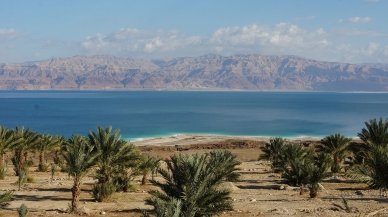
The Dead Sea
The Dead Sea is a legendary resort luring thousands of people all year round. The sea is incredibly salty — eight times saltier than the ordinary seawater, so sinking is impossible.
Young people opt for Ein Gedi to spend their holiday as life is in full swing there all night and day. Older tourists and those who dream of blissful lying on the beach set forward to Ein Bokek. The atmosphere of that place is perfect for travellers to laze around in luxurious suites, well-trained maintenance staff, and excellent beaches.
Qesarya National Park
Several centuries ago, there was the city of Caesarea Palestinae, which later became Israeli Atlantis, having gone under the water. At present, the flooded ruins occupy a considerable part of the National Park.
Tourists arrive here to enjoy the beauty of nature and go diving, take their ease on the public beach, and explore the ancient ruins preserved up to date.
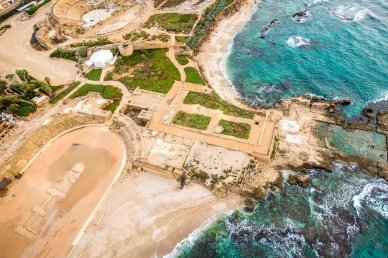
Qesarya National Park
"Travel through Time" is one of the most spectacular amusement rides. The ten-minute show displays the history of Qesarya, its origins, construction, and change. Anyone willing to see it may go inside the cinema to observe the four big screens featuring the rulers who have played a considerable role in city life. Some of them are well-known from the classes of ancient history: King Herod, Louis IX of France, and Baron Rothschild.
Food
Israel is inhabited by the ancestors of Jews who migrated there from Central and Southern Europe. Those who relocated from the central part (the Czech Republic, Germany, Slovakia, and Poland) are called Ashkenazi. People who came from Spain, Portugal, Greece, and Turkey are commonly referred to as Sephardim. The correlation between both groups is roughly the same. As a result, Israeli cuisine consists of these two directions.
Jewish culinary art is recognisable for the dishes invented by Ashkenazi. Everyone has heard of their vorschmack, gefilte fish, tzimmes, and liver pate. Meat, fish, and offal are typical to this cuisine. As the Ashkenazi Jews say, the food must be filling and fattening.
The Sephardim have the other point of view. The dishes of this orientation resemble more vegan cuisine with a predominant abundance of vegetables, fruit, and cereals. However, no matter to which direction Israeli cuisine belongs, it should comply with the Kosher certificate requirements. The types of Kosher food were described in Kashrut — the dietary code of practice, binding for every Israelite — several millennia ago.
In reality, it means that no restaurant in Israel will serve pork or rabbit meat, fish without scale and (or) fins. Unfortunately, eel, sturgeon, mackerel, and other scaleless species of fish are prohibited from consumption. During the journey, you will not be able to eat traditional seafood like shrimps, mussels, lobsters, and crayfish.
Israeli chefs consider serving a cream or cheese sauce with meat as a bad idea. According to Kashrut, a combination of meat and dairy products within one dish and even spread is unacceptable.
So what can you eat when in Israel? Local cuisine is so delicious and versatile that you will not even think about any seafood salad or pork chop.
Hummus is an indispensable dish of any breakfast, dinner, or supper in this country. It constitutes a thick puree of boiled chickpeas and tahini, combined in equal proportions. Hummus also contains such ingredients as olive oil, lemon juice, garlic, and paprika.
Msabbaha is an alternative name of hummus, considered a salad, usually eaten with cheese, aubergines, and other vegetables. Interestingly, no fork or spoon is needed while eating because pita bread is used for scooping and sending it immediately into the mouth to feel the delicious taste. The other option is to spread hummus on pita and then eat.
Falafel resembles meatballs a lot. But in fact, it is absolutely vegan food that originated in Ancient Egypt to replace meat during fasting. The balls are made of chickpea or beans puree and get stuffed with some vegetables. Then they should be deep-fried until brown.

Hummus and falafel are traditional dishes of Jewish cuisine
Baba ganoush is a feast for those who adore aubergines. They are barbecued, then mashed together with tahini, and go well with spices and green stuff. A few lemon drops will make a perfect slightly sour taste. As a rule, baba ganoush is served with yoghurt.

Baba ganoush
The Israeli like to eat shakshuka very often. It consists of poached eggs with onions, sweet pepper, and tomatoes. Though the dish is easy to cook, it is truly delicious.

Shakshuka - a traditional breakfast in Israel
In Israel, people like fish, but they consume only several species: tilapia is the most popular. Such nation-wide love stems from the Biblical legend about Peter the Apostle who caught fish and found his own coin inside it. That enabled him to make a donation for a church. Since then, tilapia has been the number one fish among the Jews. It is usually fried and served with mashed potatoes or French fries, fresh salads, and slices of lemon.
For a dessert, you may order halvah of a mouth-watering tahini taste. Israeli people use those flavourous seeds as an ingredient of any dish. To make halvah, they grind the seeds first. Then the obtained sauce is mixed with sugar, cocoa, nuts, and dried fruits. Lemon juice is added to balance the taste and avoid abundant sweetness.
The most distinctive dessert in the country is knafeh — cooked of brined goat’s cheese covered with a thin layer of peculiar noodle threads of bright orange colour. Each portion is soaked in sweet syrup and decorated with nuts and fruit slices. The taste is unique: this sweet-and-salty dessert is worth savouring for everyone interested in authentic Israeli cuisine.

In Israel, knafeh is the most delicious dish
Also, visit the baker’s shops. Though many of them offer seemingly the same things everywhere, like pita bread, buns, and puff pastry, their taste is different at every bakery. The very zest of each baked product stems from old family recipes of bakers. By the way, an Israeli baker’s shop is the place where you may have a rich breakfast, dinner, and supper as it functions as a bakery and a small family cafe at the same time.
Ordering a dessert at a cafe often comes along with a cup of coffee, a traditional drink in Israel. They drink tea very rarely. Perhaps, only cappuccino can compete with coffee: local people took the fancy of it long ago.
Israel is a beautiful country with a challenging past and an equally dramatic present. The war has not stopped here yet, and city streets are full of girls and boys wearing uniforms and carrying machine guns. Nonetheless, there is the hustle and bustle of modern life. Israeli nature delights with bright colours, and beaches welcome with warm sand and crystal clear seawater. You have to come here at least once to witness and feel the ambiance.
FAQ
When did Israel become a nation?
Israel declared independence and became a nation on May 14, 1948.
What was Israel called before 1948?
Before 1948, the region was known as Palestine, under British administration following the collapse of the Ottoman Empire after World War I.
What territories does Israel own?
Israel's sovereign territory includes its pre-1967 borders, but it also controls the West Bank, Golan Heights, and East Jerusalem, territories whose status and borders are subject to ongoing disputes and negotiations.
What is the total area of Israel?
The total area of Israel, excluding the occupied territories, is approximately 20,770 square kilometers.
What is Israel known for?
Israel is known for its rich historical and religious heritage, technological innovations, vibrant cultural scene, and as a center for major Abrahamic religions.
Is Israel's capital Tel Aviv or Jerusalem?
Israel declares Jerusalem as its capital. Many international bodies and countries, however, do not officially recognize Jerusalem as the capital and maintain their embassies in Tel Aviv.
What is the population of Israel?
The population of Israel is around 9.3 million people.
What are the main religions of Israel?
The main religions in Israel are Judaism, Islam, and Christianity.
Who is ruling Israel now?
The Prime Minister is the head of government in Israel. The political situation can change rapidly, so it's best to check the most current source for the latest information.
Is Israel doing well economically?
Israel has a strong, high-tech economy, known for its innovation, technology startups, and research and development.
What is Israel's main source of money?
Israel's economy is diverse; major sources of income include technology, tourism, diamond exports, and manufacturing.
What is Israel's main currency?
The currency of Israel is the New Israeli Shekel (ILS).
Is Israel tourist friendly?
Yes, Israel is generally tourist-friendly, offering a range of historical, cultural, and natural attractions.
Are tourists allowed in Israel now?
Tourist entry into Israel often depends on current global and regional situations, including health and security considerations. It's best to check for the latest travel advisories and entry requirements.
Is Israel an expensive country to visit?
Israel can be quite expensive for tourists, with high costs for accommodation, transportation, and food in major cities.
What documents are needed to visit Israel?
Visitors typically need a passport valid for at least six months from the date of entry. The visa requirements depend on the traveler's nationality.
Do I need a visa to Israel?
Visa requirements for Israel vary by nationality. Many countries have visa exemption agreements with Israel for short visits, while others need to apply for a visa beforehand.







